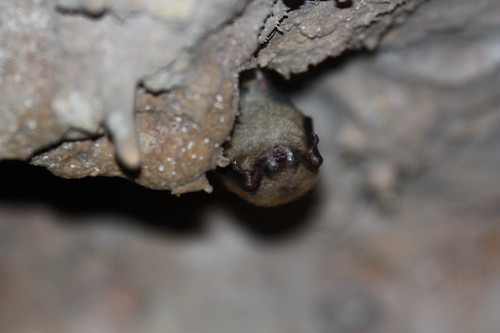Onondaga Cave State Park’s cave will remain open for tour season; disease has not been found to infect humans
For more information: 573-751-1010
Volume 41-005 FOR IMMEDIATE RELEASE: January 25, 2013
 |
ittle brown bat with visible fungus collected at Onondaga Cave
Photo credit: MDC/Shelly Colatskie
|
JEFFERSON CITY, Mo. — Missouri State Parks has received confirmation that a bat found in the entrance of Onondaga Cave at Onondaga Cave State Park in Crawford County has tested positive with white-nose syndrome. WNS spreads mainly through bat-to-bat contact and has not been found to infect people, pets or livestock but is harmful or lethal to hibernating bats. The fungus that causes WNS may be inadvertently carried between caves by humans through clothing and equipment.
The U.S. Geological Survey’s National Wildlife Health Center http://www.nwhc.usgs.gov confirmed the bat had the disease described as a white fungus, or Geomyces destructans, which is typically found on the faces and wings of infected bats.
Education is an important aspect of the overall effort to manage WNS and part of the state park system mission. In 2010, Missouri State Parks staff began educating and screening visitors before each cave tour to help minimize risks to bats. While WNS is mainly transmitted bat to bat, scientists believe that the fungus can be carried on clothing, footwear and caving gear, therefore, staff will require visitors to wear only clothing and bring equipment that has not been in another cave before. In addition, staff took action to protect the bats from disturbance while hibernating in caves and adjusted the touring season to avoid disturbing the bats in fall and spring when they are gathering for, or preparing to leave, hibernation.
Missouri State Parks has a dual responsibility of preserving nature while providing opportunities for people to enjoy our state parks. Nearly 20,000 people visit Onondaga Cave every year. Staff will continue to provide information and require additional measures for visitors to follow both before and after a cave tour when the cave opens for the tour season to help reduce the risk of cave-to-cave transmission of the fungus.
The U.S. Fish and Wildlife Service has indicated that WNS has killed at least 5.5 million cave-dwelling bats since the disease was first detected in New York in 2006. Signs of the disease have spread to 21 states and the disease has been confirmed in 19 states and four Canadian provinces. Signs of the disease were first discovered in Missouri in 2010. Today, signs of the disease or the fungus have been confirmed in 15 bats from caves in Pike, Shannon, Lincoln, Perry, Washington and now Crawford counties.
More information on WNS is available at www.whitenosesyndrome.org. For more information on Missouri State Parks and Onondaga Cave State Park, visit the Web at mostateparks.com. Missouri State Parks is a division of the Missouri Department of Natural Resources.





No comments:
Post a Comment